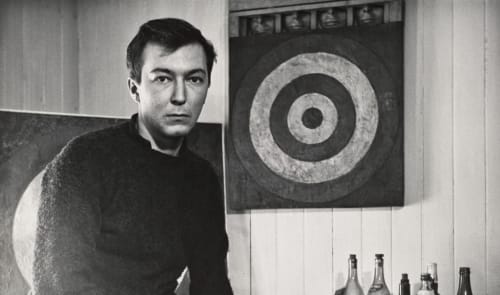“I’m interested in things which suggest the world rather than reproduce it, and I’ve always wanted to make things which are difficult to describe.”
Widely regarded as one of the pivotal figures of American postwar art, Jasper Johns (b. 1931, Augusta, Georgia) has redefined the parameters of modern painting and sculpture. Raised in South Carolina, Johns declared his intention to become an artist at the age of five. After brief studies at the University of South Carolina and the Parsons School of Design, he was drafted into the United States Army in 1951, serving in the Korean War.
Returning to New York in 1953, Johns entered a period of artistic self-discovery and collaboration, forming a relationship with fellow artist Robert Rauschenberg. During this time, Johns began developing a radical new visual language grounded in the familiar—icons of everyday life such as flags, targets, numbers, maps, and quotidian objects—what he famously referred to as “things the mind already knows.” In 1954, in a decisive act of renewal, Johns destroyed all of his earlier work, marking the beginning of what would become a lifelong exploration of the ambiguity of signs and the instability of meaning.
Johns’s first solo exhibition at the Leo Castelli Gallery in 1958 had a profound effect on the New York art world. Johns challenged prevailing notions of abstraction and authorship. His use of encaustic—pigmented wax layered over collaged newspaper—emphasized the objecthood of the painting itself, collapsing distinctions between image and object, content and form. His work broke decisively from the emotive intensity of Abstract Expressionism, offering instead a novel approach that paved the way for Pop, Minimal, and Conceptual art.
Throughout the 1960s and 70s, Johns continued to develop his visual lexicon. From the mechanical crosshatch motifs that dominated his paintings in the 1970s to the incorporation of found objects, body casts, and allusions to classical and modern art history, Johns’s work remained grounded in a rigorous examination of visual and linguistic systems. As his practice evolved, so too did the emotional register of his work—what began as formal inquiry deepened into more autobiographical territory, often layered with memory, loss, and self-reflection.
A master of multiple mediums, Johns is also celebrated as one of the most significant printmakers of the modern era, with an oeuvre that spans lithography, intaglio, screenprinting, and monotype. His long-standing collaborations with Universal Limited Art Editions (ULAE) expanded the boundaries of printmaking, establishing it as a conceptual and experimental counterpart to painting and sculpture. Johns's collaborations with figures such as composer John Cage and choreographer Merce Cunningham further exemplify the interdisciplinary reach of his vision. His set designs for Walkaround Time (1968), inspired by Marcel Duchamp’s The Large Glass, underscore his role as a bridge between European Dada and the American avant-garde.
In recent decades, Johns has embraced more intimate and enigmatic compositions, often drawing on personal motifs, literary references, and historical artworks. Series such as The Seasons (1987) and Catenary (1999–2003) reflect a deepening preoccupation with time, perception, and the cyclical nature of experience. His legacy continues to shape the trajectory of contemporary art, not only through his pioneering early works but also through a persistent commitment to experimentation and the unresolved nature of seeing.
